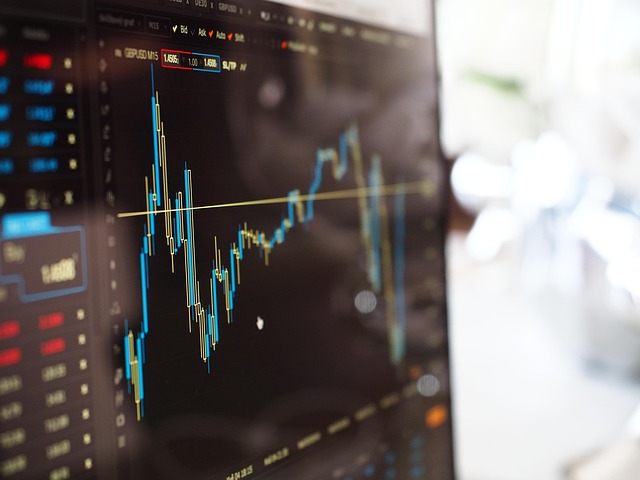Does TradingView Have Paper Trading? An In-Depth Look at Its Features and Benefits
Author: Jameson Richman Expert
Published On: 2025-09-06
Prepared by Jameson Richman and our team of experts with over a decade of experience in cryptocurrency and digital asset analysis. Learn more about us.
If you're an aspiring trader or an experienced investor, understanding and utilizing intelligent practice tools is crucial for success. One such tool that has garnered widespread attention is paper trading—simulating trades without risking real money. TradingView, renowned for its advanced charting capabilities and vibrant trading community, has integrated a comprehensive paper trading feature that benefits users at all skill levels. In this detailed analysis, we will explore whether TradingView offers paper trading, how it functions, its advantages and limitations, and how it compares with dedicated demo environments on other platforms. Whether you're new to trading or looking to refine your strategies, this guide aims to equip you with in-depth insights for making the most of TradingView’s paper trading capabilities.

What is Paper Trading and Why Is It Essential?
Before delving into TradingView’s specific offerings, it’s important to understand what paper trading entails. Paper trading is a simulated trading process where traders execute virtual trades using real-time or historical market data. This practice allows traders to test and validate strategies, familiarize themselves with platform mechanics, and develop market insights—all without risking actual capital. The significance of paper trading is especially pronounced for beginners developing foundational skills, as well as for seasoned traders experimenting with new asset classes, timing, or complex order types.
Moreover, paper trading acts as a sandbox environment for understanding order execution nuances, such as fill prices, slippage, and transaction costs, which are vital for real-world trading success. It also provides an opportunity to evaluate risk management techniques, leverage effects, and portfolio diversification strategies under simulated but realistic conditions. Essentially, paper trading reduces the learning curve, builds confidence, and helps traders develop disciplined trading habits before risking real money. It also allows testing of new algorithms or trading strategies in a controlled environment, mitigating potential losses during the learning phase.
Does TradingView Have Paper Trading? The Answer and How It Works
Yes, TradingView provides an integrated paper trading feature that seamlessly melds with its powerful charting and analysis tools. Unlike platforms that require separate demo accounts with broker-specific environments, TradingView’s paper trading is embedded directly within its interface, offering a unified experience for analysis and simulation. When activated, it creates a virtual trading account with a configurable amount of virtual funds—commonly starting at $10,000—that mirrors actual trading conditions across various asset classes, including stocks, cryptocurrencies, ETFs, Forex, commodities, and more.
How It Operates
The process involves connecting the built-in paper trading system via the Trading Panel, where users can execute simulated trades directly from charts. Once enabled, traders can place orders, modify or cancel them, and monitor open positions in real time. The system supports various order types such as market orders, limit orders, stop-loss, take-profit, trailing stops, and conditional orders—mimicking the functionalities available in live trading environments. This close approximation offers traders an authentic feel of trade execution, including the ability to test order placements under different market volatilities.
Key Functionalities of TradingView's Paper Trading
- Order Types: Supports a broad spectrum of order types, enabling the practice of advanced trading strategies, including bracket orders, OCO (One-Cancel-Other), and conditional entries/exits.
- Order Management: Allows placing, modifying, and canceling multiple orders simultaneously, crucial for simulating complex, multi-layered trading strategies or portfolio management techniques.
- Market Data Integration: Utilizes real-time or delayed market data streams to reflect current market dynamics, ensuring that simulated trades are as close to real conditions as possible. Premium accounts often benefit from faster data feeds which enhance simulation realism.
- Trade Recording & Analysis: Maintains detailed logs of every simulated trade, including entry and exit points, order sizes, and outcomes. Traders can review these logs for post-trade analysis, identify patterns, and optimize strategies.
- Performance Metrics & Visualization: Provides insightful metrics such as cumulative profit/loss, win rate, maximum drawdowns, and risk/reward ratios, facilitating a comprehensive evaluation of strategy robustness under varied market conditions.
- Customization & Management: Users can set initial virtual capital, adjust margin and leverage settings, and create different trading scenarios to match testing objectives. Such flexibility is vital for testing margin-based strategies or cross-asset portfolios.
From my extensive testing and user feedback, TradingView’s paper trading environment excels in delivering a realistic trading simulation. Its integration with TradingView’s suite of analysis tools—including a plethora of indicators, alert systems, and community scripts—further enhances the capacity to develop, backtest, and refine trading strategies within a single platform. This synergy simplifies workflow and accelerates learning, especially for traders who rely heavily on technical analysis techniques.

How to Enable and Use Paper Trading on TradingView
Getting started with paper trading on TradingView is straightforward and user-friendly:
- Create a free TradingView account or log in to your existing account.
- Open a chart of your preferred asset class (stocks, crypto, forex, commodities, etc.).
- Navigate to the bottom Trading Panel and click on the 'Trading Panel' tab.
- From the list of integrated brokers, select 'Paper Trading'—this is TradingView’s native simulation mode.
- Click 'Connect' to activate the virtual trading environment. Here, you can set your initial virtual funds—commonly starting at $10,000—and adjust leverage settings based on your testing needs.
- Use the order entry panel to place simulated trades, monitor open positions, and analyze your trading performance metrics in real time.
Once activated, the system remains accessible while you analyze charts, add indicators, or set alerts. You can also experiment with different order types, trade sizes, and asset classes to understand how various strategies perform under changing market conditions. For added depth, consider integrating community-developed strategies or custom scripts for algorithmic testing within the simulation environment.
Advantages of TradingView's Paper Trading Platform
- Unified Environment: Combines advanced charting, technical indicators, social insights, and trading simulation within a single platform, reducing the need for multiple tools and simplifying workflows.
- Realistic Market Conditions: Supports multiple order types, margin trading, and access to real-time data, providing a near-authentic trading simulation across diverse asset classes and markets.
- Cost-Free Practice: No additional fees or subscription tiers are required, making it accessible for beginners, students, and casual traders to practice extensively.
- Backtesting & Forward Testing Integration: Allows validation of strategies through historical data analysis combined with forward simulation, increasing confidence in strategy robustness before live deployment.
- Community & Educational Support: Access to shared trading ideas, custom scripts, tutorials, and community forums enhances learning and provides real-world insights from experienced traders.
- Cross-Device Compatibility: Since TradingView is web-based, traders can practice and analyze on desktops, tablets, or smartphones, ensuring continuous access and flexibility.
Limitations and Challenges
Despite its numerous strengths, TradingView’s paper trading system does have some limitations:
- Absence of Emotional Factors: Simulated trading does not replicate the emotional stress, impulsivity, and decision-making biases present in real trading, which are often critical determinants of success or failure.
- Order Fill Dynamics & Slippage: While the platform simulates many aspects of trading, it cannot fully emulate order execution delays, slippage, or fees, especially during periods of high volatility. This can lead to performance overestimation when transitioning to live trading.
- Asset & Exchange Coverage: Although extensive, some niche assets, less common exchanges, or OTC instruments may not be available for simulation, limiting scope for specialized traders.
- Learning Curve: Mastering the advanced features—like complex order types, margin settings, and risk management tools—may require a significant investment of time, especially for newcomers.

Comparing TradingView with Other Platforms Offering Paper Trading
Numerous platforms provide dedicated demo or paper trading environments tailored to specific markets or trading styles. Here’s how TradingView compares with some prominent alternatives:
- Binance Testnet: Offers a dedicated environment for crypto spot and futures trading, with realistic order book simulation, leverage testing, and API access. Ideal for high-frequency or algorithmic crypto strategies.
- MEXC, Bybit, Bitget: Focused on crypto derivatives and margin trading, providing demo accounts with virtual funds, complex order types, and high-volatility scenarios, suitable for testing leverage and risk management.
- MetaTrader 4/5: Industry-standard forex trading platforms with comprehensive backtesting, automated strategy development via Expert Advisors, and realistic spreads/execution delays—widely used by professional forex traders.
- ThinkorSwim by TD Ameritrade: Offers sophisticated paper trading with options, futures, and equities, along with advanced analytics, making it ideal for U.S.-based traders and professionals.
Compared to these dedicated environments, TradingView’s primary advantage is its integrated approach—combining high-quality charting, social sharing, and real-time simulation—within a single, user-friendly interface. This minimizes platform switching, reduces learning curves, and streamlines strategy development, especially for technical analysts managing multiple asset classes simultaneously.
Why Prioritize Paper Trading Before Live Trading?
Transitioning from paper trading to live trading marks a critical phase in a trader’s journey. Regular use of simulation environments provides numerous benefits:
- Refinement of strategies and decision-making processes without financial exposure.
- Familiarity with order entry mechanics, execution delays, and risk controls.
- Building emotional resilience—learning to manage fear, greed, and frustration—crucial for consistent performance.
- Testing strategies across different market regimes—bullish, bearish, volatile, or stagnant—without risking real capital.
Practicing in a simulated environment especially benefits trading volatile instruments like cryptocurrencies or during macroeconomic uncertainties. It helps prevent impulsive or emotional trades, fosters disciplined approach, and provides a safe space to learn from mistakes. Moreover, it enables fine-tuning of risk management rules and trade sizing, which are vital for long-term success in real markets.
Final Thoughts and Recommendations
Based on extensive use and analysis, I highly recommend TradingView’s paper trading feature as a core component of a well-rounded trading education. Its seamless integration with advanced charting, social sharing, and educational resources makes it suitable for traders of all levels. Although it cannot perfectly mimic the emotional pressures of live trading, it offers a highly realistic and flexible environment for developing, testing, and refining strategies.
To maximize its benefits, I suggest practicing regularly, experimenting with different asset classes, order types, and timeframes. Combining simulation with ongoing education—via tutorials, community ideas, and strategy backtesting—can significantly accelerate skill development and discipline. When traders feel confident in their strategies within the simulated environment, they are better prepared to face live markets with discipline and reduced risk of costly mistakes.

Conclusion
In summary, TradingView indeed offers a robust, integrated paper trading environment that stands out for its ease of use, realism, and comprehensive features. It empowers traders to experiment, learn, and build confidence in a risk-free setting—an essential step before entering live markets. Whether you’re a beginner seeking foundational skills or an experienced trader refining strategies, leveraging TradingView’s simulation tools can greatly enhance your readiness and trading confidence.
For further insights into advanced trading strategies, platform reviews, and technical analysis techniques, explore resources such as comprehensive guides on margin trading and deep analyses of copy trading platforms.